Do not trust emails falsely claiming that your email account will be removed
Phishing/ScamAlso Known As: Removal From Server Has Been Approved And Initiated phishing email
Get free scan and check if your device is infected.
Remove it nowTo use full-featured product, you have to purchase a license for Combo Cleaner. Seven days free trial available. Combo Cleaner is owned and operated by RCS LT, the parent company of PCRisk.com.
What is the "Removal From Server Has Been Approved And Initiated" email?
"Removal From Server Has Been Approved And Initiated" is a spam email received and subsequently analyzed by our researchers. We have determined that it is a phishing scam targeting recipients' email account log-in credentials.
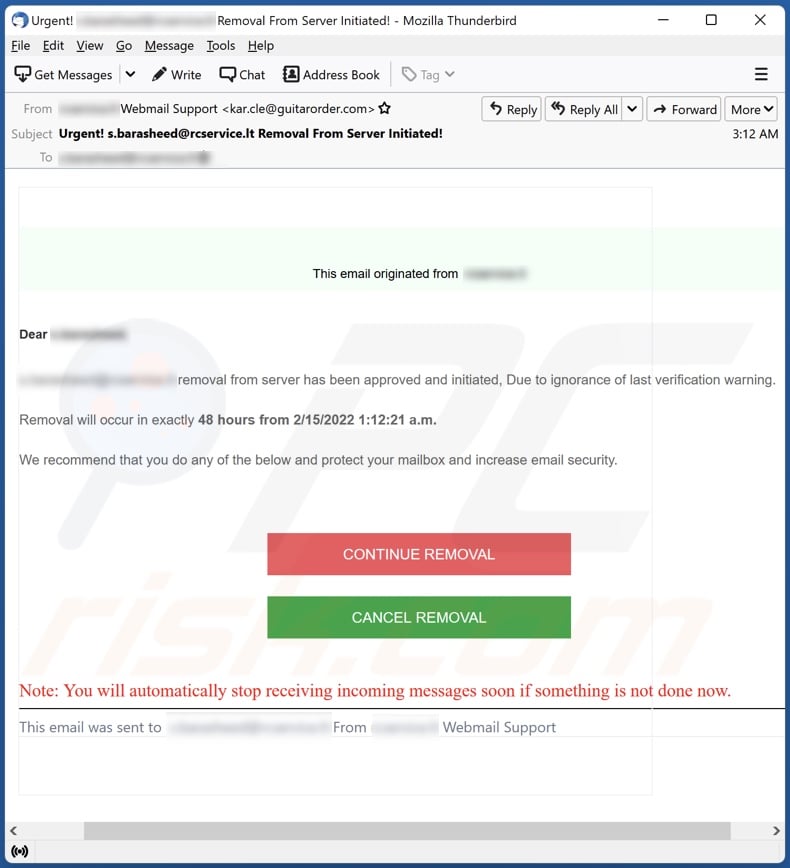
"Removal From Server Has Been Approved And Initiated" email scam overview
The spam email is presented as an urgent warning from the recipient's email support. It claims the email account was not verified, and since the last warning was ignored - the removal process has been approved and initiated. The account will be removed after 48 hours from the listed date.
To stop this process and increase the email's security, the scam letter urges the recipient to select the option presented in it. Pressing said button results in a redirect to a phishing website.
It must be emphasized that all the claims made by this message are false, and it is in no way associated with any legitimate email service providers.
When we visited the phishing page, it was disguised as the Google Translate site, which could not be reached. Atop this webpage was a pop-up stating that the session had expired. The pop-up requested visitors to sign in - in order to continue.
Attempting to log in using the email account's password - would result in this information being exposed to the scammers. With this data in their possession, the cyber criminals could access the victim's email account and potentially the content connected to it (e.g., accounts/platforms registered through the email).
To summarize, by trusting the "Removal From Server Has Been Approved And Initiated" email - users can experience severe privacy issues, financial losses, and even identity theft.
If you have entered your credentials into the phishing site, we advise immediately changing the passwords of all potentially exposed accounts and contacting their official support.
| Name | Removal From Server Has Been Approved And Initiated phishing email |
| Threat Type | Phishing, Scam, Social Engineering, Fraud |
| Fake Claim | Recipient's email account is pending removal unless a verification is completed. |
| Disguise | Warning from the recipient's email support. |
| Related Domains | translate[.]goog |
| Detection Names (translate[.]goog) | N/A (VirusTotal) |
| Serving IP Address (translate[.]goog) | 142.250.148.132 |
| Symptoms | Unauthorized online purchases, changed online account passwords, identity theft, illegal access of the computer. |
| Distribution methods | Deceptive emails, rogue online pop-up ads, search engine poisoning techniques, misspelled domains. |
| Damage | Loss of sensitive private information, monetary loss, identity theft. |
| Malware Removal (Windows) |
To eliminate possible malware infections, scan your computer with legitimate antivirus software. Our security researchers recommend using Combo Cleaner. Download Combo CleanerTo use full-featured product, you have to purchase a license for Combo Cleaner. 7 days free trial available. Combo Cleaner is owned and operated by RCS LT, the parent company of PCRisk.com. |
Spam campaigns in general
We have inspected thousands of spam emails. "Important Update From Mail Server Registrar", "Your eMail account will be disconnected", and "Closing Of Email Address Notice !" are just a few examples of those similar to "Removal From Server Has Been Approved And Initiated".
Letters of this type are usually presented as "official", "urgent", "important", and so on. In addition to being used for phishing and various scams (e.g., sextortion, fake tech support, hoax lotteries, etc.), spam mail is also used to proliferate trojans, ransomware, cryptocurrency miners, and other malware.
How do spam campaigns infect computers?
Spam emails can have infectious files attached to them. Alternatively, they can contain links leading to malicious websites designed to trick visitors into downloading/installing such files or ones capable of stealthily accomplishing that. Virulent files can be archives, executables, PDF and Microsoft Office documents, JavaScript, etc. When the files are opened - the infection process is triggered.
For example, when infectious documents are opened in Microsoft Office versions released before 2010 - they immediately execute malicious macro commands. Later versions have "Protected View" mode, so users have to enable macros (i.e., editing/content) manually. It is noteworthy that most virulent documents include deceptive messages intended to lure users into enabling macro commands.
How to avoid installation of malware?
We strongly advise against opening/clicking the attachments and links present in dubious mail - as doing so can result in a malware infection. Additionally, we recommend using Microsoft Office versions released after 2010.
However, malware is spread using various methods. Therefore, we also advise downloading from official/verified sources and activating/updating software with tools/functions provided by legitimate developers.
We must emphasize the importance of having a reputable anti-virus installed and updated. Security programs must be used to run regular system scans and to remove threats and issues. If you've already opened malicious attachments, we recommend running a scan with Combo Cleaner Antivirus for Windows to automatically eliminate infiltrated malware.
Text presented in the "Removal From Server Has Been Approved And Initiated" email letter:
Subject: Urgent! ******** Removal From Server Initiated!
This email originated from ********
Dear ********,
******** removal from server has been approved and initiated, Due to ignorance of last verification warning.
Removal will occur in exactly 48 hours from 2/15/2022 1:12:21 a.m.
We recommend that you do any of the below and protect your mailbox and increase email security.
CONTINUE REMOVAL
CANCEL REMOVAL
Note: You will automatically stop receiving incoming messages soon if something is not done now.
This email was sent to ******** From ******** Webmail Support
Screenshots of the phishing websites promoted by the "Removal From Server Has Been Approved And Initiated" spam campaign:
Other examples of emails from "Removal From Server Has Been Approved And Initiated" spam campaign:
Sample 1:
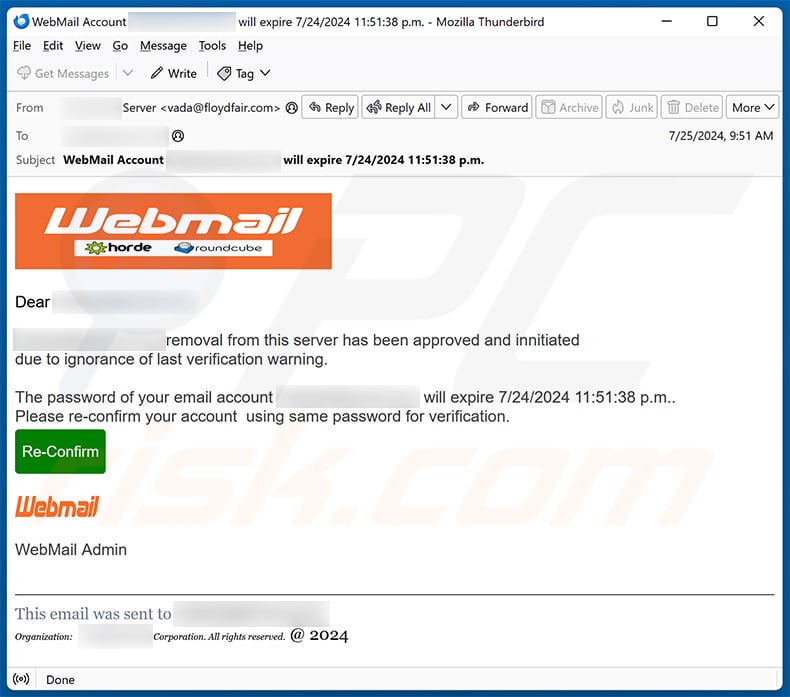
Text presented within:
Subject: WebMail Account ******** will expire 7/24/2024 11:51:38 p.m.
Dear **************** removal from this server has been approved and innitiated
due to ignorance of last verification warning.The password of your email account ******** will expire 7/24/2024 11:51:38 p.m..
Please re-confirm your account using same password for verification.Re-Confirm
WebMail Admin
This email was sent to ********
Organization: ******** Corporation. All rights reserved. @ 2024
Sample 2:
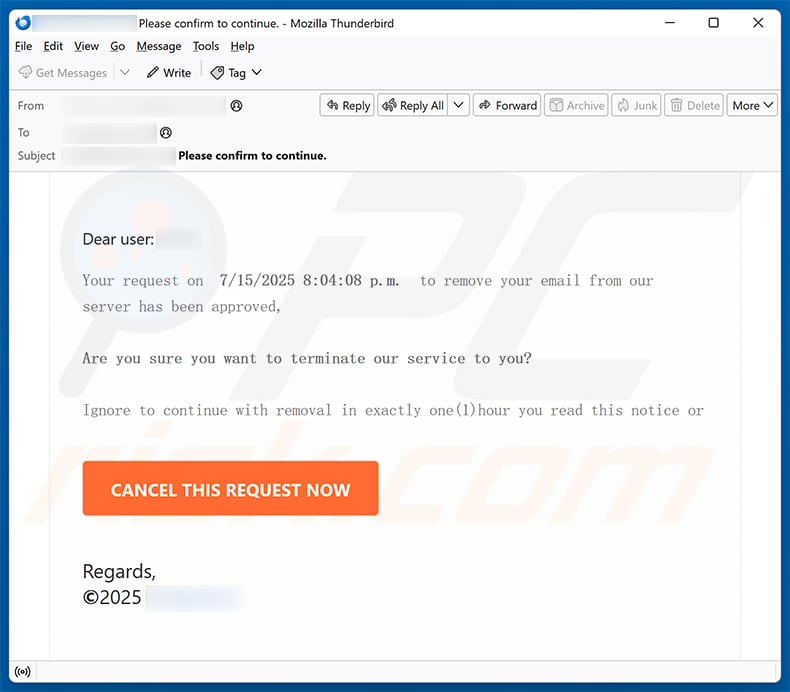
Text presented within:
Subject: [********]: Please confirm to continue.
Dear user: -
Your request on 7/15/2025 8:04:08 p.m. to remove your email from our server has been approved,
Are you sure you want to terminate our service to you?
Ignore to continue with removal in exactly one(1)hour you read this notice or
CANCEL THIS REQUEST NOWRegards,
©2025 ********.cPanel, L.L.C, 2550 North Loop West, Suite 4006, Houston, TX 77092, USA.
Instant automatic malware removal:
Manual threat removal might be a lengthy and complicated process that requires advanced IT skills. Combo Cleaner is a professional automatic malware removal tool that is recommended to get rid of malware. Download it by clicking the button below:
DOWNLOAD Combo CleanerBy downloading any software listed on this website you agree to our Privacy Policy and Terms of Use. To use full-featured product, you have to purchase a license for Combo Cleaner. 7 days free trial available. Combo Cleaner is owned and operated by RCS LT, the parent company of PCRisk.com.
Quick menu:
- What is Removal From Server Has Been Approved And Initiated phishing email?
- Types of malicious emails.
- How to spot a malicious email?
- What to do if you fell for an email scam?
Types of malicious emails:
![]() Phishing Emails
Phishing Emails
Most commonly, cybercriminals use deceptive emails to trick Internet users into giving away their sensitive private information, for example, login information for various online services, email accounts, or online banking information.
Such attacks are called phishing. In a phishing attack, cybercriminals usually send an email message with some popular service logo (for example, Microsoft, DHL, Amazon, Netflix), create urgency (wrong shipping address, expired password, etc.), and place a link which they hope their potential victims will click on.
After clicking the link presented in such email message, victims are redirected to a fake website that looks identical or extremely similar to the original one. Victims are then asked to enter their password, credit card details, or some other information that gets stolen by cybercriminals.
![]() Emails with Malicious Attachments
Emails with Malicious Attachments
Another popular attack vector is email spam with malicious attachments that infect users' computers with malware. Malicious attachments usually carry trojans that are capable of stealing passwords, banking information, and other sensitive information.
In such attacks, cybercriminals' main goal is to trick their potential victims into opening an infected email attachment. To achieve this goal, email messages usually talk about recently received invoices, faxes, or voice messages.
If a potential victim falls for the lure and opens the attachment, their computers get infected, and cybercriminals can collect a lot of sensitive information.
While it's a more complicated method to steal personal information (spam filters and antivirus programs usually detect such attempts), if successful, cybercriminals can get a much wider array of data and can collect information for a long period of time.
![]() Sextortion Emails
Sextortion Emails
This is a type of phishing. In this case, users receive an email claiming that a cybercriminal could access the webcam of the potential victim and has a video recording of one's masturbation.
To get rid of the video, victims are asked to pay a ransom (usually using Bitcoin or another cryptocurrency). Nevertheless, all of these claims are false - users who receive such emails should ignore and delete them.
How to spot a malicious email?
While cyber criminals try to make their lure emails look trustworthy, here are some things that you should look for when trying to spot a phishing email:
- Check the sender's ("from") email address: Hover your mouse over the "from" address and check if it's legitimate. For example, if you received an email from Microsoft, be sure to check if the email address is @microsoft.com and not something suspicious like @m1crosoft.com, @microsfot.com, @account-security-noreply.com, etc.
- Check for generic greetings: If the greeting in the email is "Dear user", "Dear @youremail.com", "Dear valued customer", this should raise suspiciousness. Most commonly, companies call you by your name. Lack of this information could signal a phishing attempt.
- Check the links in the email: Hover your mouse over the link presented in the email, if the link that appears seems suspicious, don't click it. For example, if you received an email from Microsoft and the link in the email shows that it will go to firebasestorage.googleapis.com/v0... you shouldn't trust it. It's best not to click any links in the emails but to visit the company website that sent you the email in the first place.
- Don't blindly trust email attachments: Most commonly, legitimate companies will ask you to log in to their website and to view any documents there; if you received an email with an attachment, it's a good idea to scan it with an antivirus application. Infected email attachments are a common attack vector used by cybercriminals.
To minimise the risk of opening phishing and malicious emails we recommend using Combo Cleaner Antivirus for Windows.
Example of a spam email:

What to do if you fell for an email scam?
- If you clicked on a link in a phishing email and entered your password - be sure to change your password as soon as possible. Usually, cybercriminals collect stolen credentials and then sell them to other groups that use them for malicious purposes. If you change your password in a timely manner, there's a chance that criminals won't have enough time to do any damage.
- If you entered your credit card information - contact your bank as soon as possible and explain the situation. There's a good chance that you will need to cancel your compromised credit card and get a new one.
- If you see any signs of identity theft - you should immediately contact the Federal Trade Commission. This institution will collect information about your situation and create a personal recovery plan.
- If you opened a malicious attachment - your computer is probably infected, you should scan it with a reputable antivirus application. For this purpose, we recommend using Combo Cleaner Antivirus for Windows.
- Help other Internet users - report phishing emails to Anti-Phishing Working Group, FBI’s Internet Crime Complaint Center, National Fraud Information Center and U.S. Department of Justice.
Frequently Asked Questions (FAQ)
Why did I receive this email?
Spam emails are not personal; thousands of users receive the same letter. Cyber criminals distribute these emails in the hopes that at least some of the recipients will be tricked by them.
I have provided my personal information when tricked by this spam email, what should I do?
If you have provided account credentials - immediately change the passwords of all compromised accounts and inform their official support. And if you have disclosed other private data (e.g., credit card numbers, ID card details, etc.) - contact the corresponding authorities without delay.
I have read a spam email but didn't open the attachment, is my computer infected?
Just opening/reading a spam email will not trigger any infection processes. Malware is spread via the attachments and links present in spam mail.
I have downloaded and opened a file attached to a spam email, is my computer infected?
Whether an infection occurred - depends on the opened file's format. Executables (.exe, .run, etc.) initiate malware download/installation upon opening almost without fail. However, you might have avoided an infection if it was a document (.doc, .xls, .pdf, etc.). These formats may require additional actions (e.g., enabling macro commands) to start downloading/installing malicious software.
Will Combo Cleaner remove malware infections present in email attachments?
Yes, Combo Cleaner can detect and eliminate nearly all known malware infections. However, it must be stressed that performing a complete system scan is crucial - as high-end malicious programs tend to hide deep within systems.
Share:

Tomas Meskauskas
Expert security researcher, professional malware analyst
I am passionate about computer security and technology. I have an experience of over 10 years working in various companies related to computer technical issue solving and Internet security. I have been working as an author and editor for pcrisk.com since 2010. Follow me on Twitter and LinkedIn to stay informed about the latest online security threats.
PCrisk security portal is brought by a company RCS LT.
Joined forces of security researchers help educate computer users about the latest online security threats. More information about the company RCS LT.
Our malware removal guides are free. However, if you want to support us you can send us a donation.
DonatePCrisk security portal is brought by a company RCS LT.
Joined forces of security researchers help educate computer users about the latest online security threats. More information about the company RCS LT.
Our malware removal guides are free. However, if you want to support us you can send us a donation.
Donate
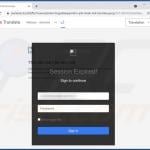
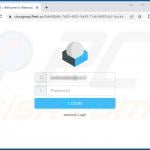
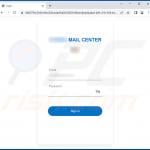
▼ Show Discussion